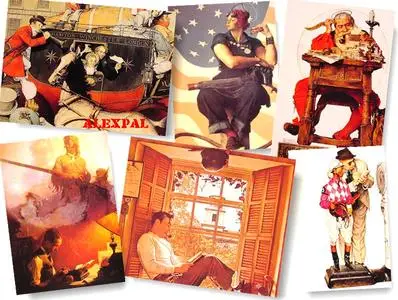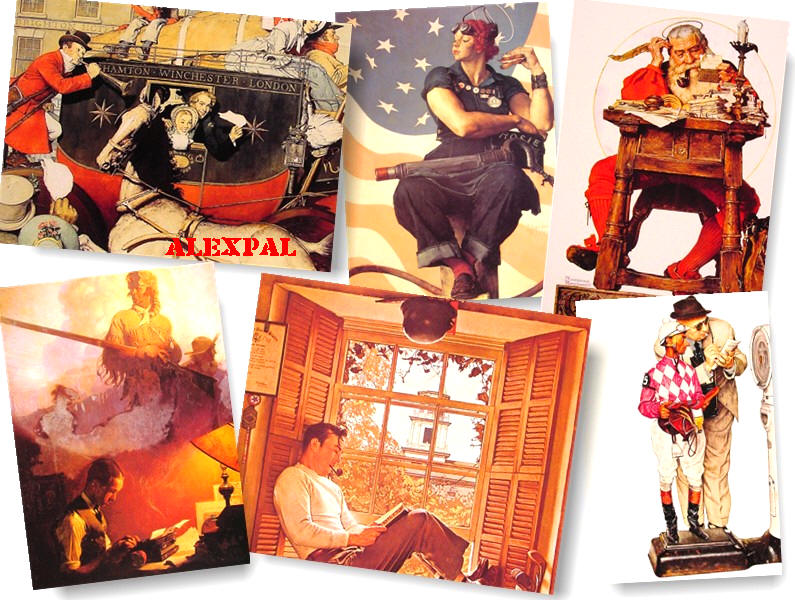Art by Norman Rockwell
103 JPG | up to 900x1200 | 26 Mb
103 JPG | up to 900x1200 | 26 Mb
Norman Percevel Rockwell (February 3, 1894 – November 8, 1978) was a 20th century American painter and illustrator. His works enjoy a broad popular appeal in the United States, where Rockwell is most famous for the cover illustrations of everyday life scenarios he created for The Saturday Evening Post magazine over more than four decades. Among the best-known of Rockwell's works are Rosie the Riveter (although his Rosie was reproduced less than others of the day), Saying Grace (1951), and the Four Freedoms series.
Rockwell married his first wife, Irene O\'Connor, in 1916. Irene was Rockwell\'s model in Mother Tucking Children into Bed, published on the cover of The Literary Digest on January 19, 1921. However, the couple divorced in 1930. He quickly married schoolteacher Mary Barstow, with whom he had three children: Jarvis Waring, Thomas Rhodes and Peter Barstow. In 1939, the Rockwell family moved to Arlington, Vermont, which seemed to inspire him to paint scenes of everyday small town American life. Rockwell also was commissioned for several Christmas projects during his early years.
Norman Rockwell was very prolific, and produced over 4000 original works, most of which have been either destroyed by fire or are in permanent collections. Rockwell was also commissioned to illustrate over 40 books including Tom Sawyer and Huckleberry Finn. His annual contributions for the Boy Scouts\' calendars between 1925 and 1976 (Rockwell was a 1939 recipient of the Silver Buffalo Award, the highest adult award given by the Boy Scouts of America), were only slightly overshadowed by his most popular of calendar works: the \"Four Seasons\" illustrations for Brown & Bigelow that were published for 17 years beginning in 1947 and reproduced in various styles and sizes since 1964. Illustrations for booklets, catalogs, posters (particularly movie promotions), sheet music, stamps, playing cards, and murals (including \"Yankee Doodle Dandy\", which was completed in 1936 for the Nassau Inn in Princeton, New Jersey) rounded out Rockwell\'s œuvre as an illustrator.
Many of his works appear overly sweet in modern critics\' eyes, especially the Saturday Evening Post covers, which tend toward idealistic or sentimentalized portrayals of American life—this has led to the often-deprecatory adjective Rockwellesque. Consequently, Rockwell is not considered a \"serious painter\" by some contemporary artists, who often regard his work as bourgeois and kitsch. Writer Vladimir Nabokov scorned brilliant technique put to \"banal\" use, and wrote in his book Pnin: \"That Dalí is really Norman Rockwell\'s twin brother kidnapped by Gypsies in babyhood\". He is called an \"illustrator\" instead of an artist by some critics, a designation he did not mind, as it was what he called himself.
However, in his later years, Rockwell began receiving more attention as a painter when he chose more serious subjects such as the series on racism for Look. One example of this more serious work is The Problem We All Live With, which dealt with the issue of school integration. The painting depicts a young African American girl, Ruby Bridges, flanked by white federal marshals, walking to school past a wall defaced by racist graffiti.
Download from Easy-Share
or
Download from Depositfiles
or
Download from Rapidshare
My Graphics Blog: Welcome!
or
Download from Depositfiles
or
Download from Rapidshare
My Graphics Blog: Welcome!
–––––––––––––––––––––––––-
Also:
Norman Rockwell: American Art Series by Rh Value Publishing (Author)
Publisher: Gramercy (October 16, 1989) | ISBN-10: 0517675994 | DjVu | 8,5 Mb | 112 pages
Download from Depositfiles
or
Download from Rapidshare
No MIRRORs below!
–––––––––––––––––––––––––-



